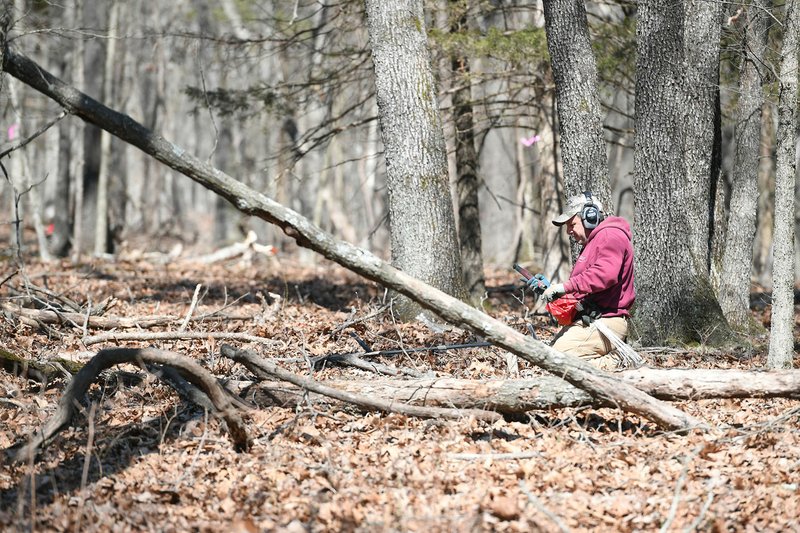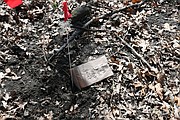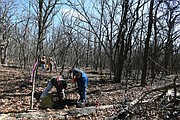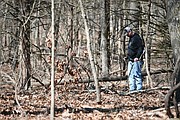A battlefield might give up some of its treasures, but it won't always share its secrets.
Archaeologists from the University of Arkansas and volunteers from the Arkansas Archaeological Society completed explorations this spring and summer at Pea Ridge National Military Park. The digs closed most of the field work on a four-year project by the Arkansas Archaeological Survey in cooperation with the National Park Service.
Luck of the dig
Sixteen-year-old Kenny Bragg of Monticello found a partial bayonet blade in his excavation pit in Foster’s field. Bragg joined more than 100 other volunteers this summer at Pea Ridge National Military Park to help conduct archeological research with the Arkansas Archeological Society.
“I pulled out about a 3-inch long piece of iron,” Bragg said. “It looked like a solid cylinder in a triangular shape.”
A great find, but Bragg didn’t seem impressed. He uncovered a complete bayonet during a dig at Elkin’s Ferry in Piggot.
“I think people found cooler things,” the teenager said.
But because of his dig, Bragg is now required to attend all Survey digs, Carl Drexler said jokingly. Drexler, the station archaeologist for the Arkansas Archeological Survey based at Southern Arkansas University in Magnolia, served as the site director for this summer’s work .
Bragg has joined his father on many other Survey projects, but the archaeology bug hit him about age 12 or 13, when his father helped a friend on a dig in Little Rock.
“I remember him playing with toy soldiers on the piles of dirt we excavated,” Drexler shared.
Bragg likes exploring with his Boy Scout troop and plans to study anthropology at the University of Arkansas on his way to becoming an archaeologist.
Along the way, the archaeologists found something curious.
Sweeping Broad Ridge -- north of Elkhorn Tavern -- with metal detectors caused beeps when the operators scanned over lead, iron and other metals hidden in the ground. Archaeologists then used shovels to dig, and Survey volunteers ran the dirt through their fingers.
They pulled out several 1-inch balls from canister shot -- not unusual for this Civil War battle site. But some of the balls had segments deliberately cut out in the shape of a pie wedge.
"My guess is they used it to make more shrapnel to make it more lethal," said Carl Drexler, site director and the Survey's station archaeologist at Southern Arkansas University in Magnolia. "I've never heard it discussed or mentioned. Nobody I've talked to has ever seen it.
"They took a lot of care to do it -- that's not an easy thing to do. That's a really weird one on me. It does not make any sense."
Steven De Vore, a National Park Service archaeologist based in Lincoln, Neb., explained that archaeological investigations at other Civil War battle sites revealed similar shrapnel cut into round or square pieces from cylindrical rods of lead. But he deferred to Drexler as the expert on the subject.
"I imagine when they ran out of ammunition, they would fill up the shot with whatever they could get into it," De Vore said. "Then they would stuff it with gunpowder. That made a really nasty weapon."
The battlefield researchers aren't sure which side was shooting the deadly pieces. They were found right in front of the Confederate artillery line -- perhaps they fell out of the Confederate cannons, or maybe the Federals were shooting at the Confederate line from their own artillery, posited Troy Banzhaf, supervisory park ranger at Pea Ridge.
Despite the unknowns, the archaeologists' work helped park officials answer some questions and pinpoint some locations, Banzhaf said. For example, they now know where the Confederates lined up their cannons on Broad Ridge.
The Missouri State Guard set up with 250 pieces of artillery firing short-range canister ammunition at Federal troops, Drexler said. "They pounded the living beejezus out of them. I'm glad I wasn't there. I can't imagine anyone surviving that."
"We found the density of impacted ammunition [on Broad Ridge] that shows they fought over an area not recounted in the history texts," he added. "We had to puzzle out who it might have been."
"It was fascinating to see how dense the pieces were, which showed the soldiers were fighting at a murderous, close range," Drexler continued. "It was a bloody conversation."
Historians of the battle know the 1st Iowa stalled out there at the beginning of the battle, Drexler said.
Banzhaf would like to see more field work behind Elkhorn Tavern, where the 9th Iowa fought. He said he wants to know the story of those Union soldiers. The 9th Iowa infantry unit was led by Lt. Col. Francis Herron and lost 218 men at Pea Ridge.
FOSTER'S FIELD
The Battle of Pea Ridge on March 7-8, 1862, was the last major battle for control of Missouri during the Civil War. The National Park Service preserves and researches the site of the Union victory.
"We'd read in the history text how the battlefield looked. Once we started digging, it started making sense, so we dug a little more," Drexler said.
Most of the artifacts found in Foster's field -- north of the Leetown stop on the park's driving tour -- were pieces of artillery ammunition, Drexler said. Archaeologists numbered and plotted each piece to its location using a highly advanced GPS system, which is accurate to within a couple of inches. Next, a computer-generated map showed each plot on the field.
"That gives us the ability to look at patterns of distribution," Drexler said.
The fighting in Foster's field involved mostly artillery roaring from both sides, with staging areas for infantry soldiers on their feet. The artifacts showed a sharp break between the sides, which were separated by several hundred feet, Drexler said.
Sixteen-year-old Ken Bragg of Monticello, a Survey volunteer, also found a partial bayonet blade in his excavation pit.
"I pulled out about a 3-inch long piece of iron," Bragg said. "It looked like a solid cylinder in a triangular shape."
Both sides in the war used bayonets when fighting at very close range. "But they never got that close here," Drexler said. "They just looked intimidating. They would have used them instead for excavation tools, holding candles, as tent pegs or their guns were stacked tip down to keep the dirt off them."
More shovel tests revealed a number of bullets, which showed no damage from being fired. Banzhaf explained soldiers dropped these bullets where they were standing.
"All rounds were in a paper cartridge tube with black powder," he explained. "And each soldier had a cartridge box on his hip. All guns were muzzle loaders, which required a lot of hands-on -- soldiers would fumble with the cartridge, powder and bullet, tearing apart the cartridge to put the powder down. And many bullets got dropped. They'd just reach for another one."
Ten UA archaeology students in a summer field school also searched for the site of Wiley Foster's farmhouse.
"It was probably a cabin at the time of the battle," Drexler said. "We were testing where history said it was."
But they didn't find the home site, Banzhaf said. "Now we have more questions that don't have answers."
"That happens frequently in archaeology," Drexler said. He said Survey archaeologists might explore other sites this winter.
LEETOWN
Archaeologists also spent two summers in the field searching for the home site of John Lee, who lived near the 19th-century Leetown.
Uncovering the fire box of the cabin's chimney helped archaeologists and park officials finally determine the orientation of the house. They also uncovered a cistern, piers for the corners and, by digging through the back yard, found a detached kitchen. Last summer, UA field school students excavated a cellar used as a trash dump and found pottery shards, animal bones, a Spy King decoder ring and bottles and more bottles from the 1940s to the 1960s. The students uncovered 100 years of farm life on the site, said Jamie Brandon, station archaeologist in Fayetteville.
Archaeologists compared the finds to aerial pictures taken in the 1940s, when the Mayfield family lived there. "We had aerial photos that showed the house from lots of different angles," Brandon said. "Finding those hard-scape features really helps you pin it down."
Brandon's group excavated a barn and four outbuildings this summer by digging through pits lined on a grid. "We found some horse tack -- some 20th century and some earlier; nails, square and round; a lot of 19th-century glass; and many artifacts from the battle." These included a general service button from a soldier's coat, which was stamped with a striped shield, and fasteners from leather pouches where soldiers stored their ammunition.
"The pieces dating to the Civil War certainly strengthen the theory that the home was used as a field hospital," Brandon said.
"It was cold on the day of the battle," Banzhaf said. "You can imagine field surgeons ripping open coats."
In addition, advanced technology used by archaeologists-- magnetometery, ground-penetrating radar and devices measuring the electric conductivity, resisitivity and magnetic susceptibility of the land -- helped locate the possible sites of other structures from Leetown, farther south than park officials estimated.
Various maps through history show anywhere from seven to 13 buildings in the Leetown area. An 1876 map shows three clusters of structures. But the accuracy of the maps is doubted.
In the detached kitchen of the Lee home, the volunteers this summer found the bowl of a reed-stem pipe, which was popular from about 1860 to 1870, Brandon reported.
George Sylvanus Lee and his family lived in the hamlet named for his ancestor from 1850 to 1880. He sold the farm to Will Mayfield, who probably expanded Lee's original log cabin. The park superintendent at the time had the Lee-Mayfield home leveled in 1963.
CLEMENTS FIELD
More brutal fighting took place in the field at the Clements house near Elkhorn Tavern. History says the home also was used as a field hospital where the Union Army housed its wounded, Banzhaf said.
"We excavated a 20th-century barn at the site," Brandon said. Other piles of rubble seemed to come from the destruction of the house, but no domestic pieces -- like dishes or glass -- were discovered, he said.
"We found a lot with a few excavations in the area, but nothing to answer questions about the house," Brandon said.
Banzhaf expressed a bit of doubt that the Clements family actually lived there -- adding to the mystery.
"To be quite honest, only one reference has given us the name Rufus Clements," he said. "He wasn't in the 1860 Census or the 1870 Census."
A report by Federal soldier Grenville Dodge mentioned a man named Clements -- the only historical record found, Banzhaf said. Dodge served as Union Gen. Ulysses Grant's intelligence chief in the western theater of the Civil War.
"The site probably became known as the Clements house because of what Dodge wrote," Banzhaf said. "Rufus might have rented the place after 1860 and before 1870."
Prior to the battle, Federal soldiers were hiding among downed trees and logs -- essentially a big brush pile -- on the southern edge of Clements' field, Banzhaf continued. Price and his Missouri guardsmen found them, shooting artillery rounds. But a bump in the field wouldn't allow their cannon barrels to adjust low enough, and the rounds flew over the heads of the Federal troops.
Then Price ordered his infantry to march on the improvised field works. "When the Confederate guardsmen got within about 10 to 15 paces of the brush, the Federal soldiers stood up and basically mowed down the Missourians," Banzhaf said. Then the Confederates retreated and began shelling again.
"It was a really significant struggle out in Clements' field, but it's something we've never identified with interpretive signs along the wayside." Banzhaf hopes to add those in the next few years.
"The Missouri State Guard records disappeared," Banzhaf continued. "So there's a lot about the unit that we don't know because we can't consult the reports."
INTERPRETATION
The National Park Service did not undertake this four-year study simply to add artifacts to the museum in the Pea Ridge park's Visitor Center, Banzhaf said.
"They didn't find anything new," he said. "We already have multiples in the museum. You can go buy a genuine Civil War bullet on eBay for $1.75. They're not that special."
However, the archaeologists and historians use other information about uncovered artillery pieces to paint the picture. Where it was found, how deep it lay buried and other artifacts found in the vicinity helped determine the battle line of Confederate artillery on Broad Ridge, Banzhaf explained.
"It's what we put on that map that tells the story," he said. "That's far more important than digging up a lot of bullets."
Historians often build the story of an event through personal accounts of folks on the scene, De Vore said, but those might not have been shared or recorded until 50 years later and might not have been accurate. "And the Army's after-action reports and maps were based on what officers remembered," he said.
The analysis of the artifacts will add more information to the story of the battle. "It's a little cloudy," he said.
"The park knows about the battle, they just need information to improve their presentation," Drexler said.
This summer, more than 100 volunteers from the Archaeological Society helped. "They can move a lot of dirt pretty fast," Brandon said.
The Society members excavated 13 units this summer in stereotypical, digging-in-a-pit fashion. The group uncovered a total of 40 pits over the last two years they've worked at the park, Brandon said. They found "thousands" of artifacts this year, all of which they washed in a field laboratory set up this summer in the Pea Ridge community building. The pieces will be archived at the Archaeological Survey office on campus in Fayetteville.
De Vore said the Park Service is pleased with the work on the 4,300 acres of Pea Ridge sites, "but they still have a lot of area in the park they haven't gotten to."
Laurinda Joenks can be reached by email at [email protected] or on Twitter @NWALaurinda.
NAN Our Town on 09/06/2018




